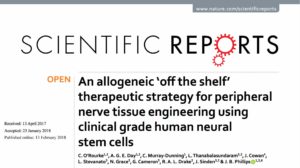News
Latest news from the group
New Publication: ‘Off the shelf’ living replacement nerve tissue
Added 13 February, 2018 This paper reports a study in which engineered neural tissue (EngNT) was made using ReNeuron's clinical grade stem cells and tested in a nerve injury model using athymic nude rats. This approach offers the possibility of developing an Advanced Therapy Medicinal Product (ATMP) using allogeneic cells which could potentially be suitable for implantation into patients with severe nerve injury. If it can be successfully translated to the clinic then this type of 'off the shelf' engineered tissue approach overcomes the limitations of current clinical nerve autograft treatments and avoids the delay and variability associated with tissue engineering using autologous cells.
This paper reports a study in which engineered neural tissue (EngNT) was made using ReNeuron's clinical grade stem cells and tested in a nerve injury model using athymic nude rats. This approach offers the possibility of developing an Advanced Therapy Medicinal Product (ATMP) using allogeneic cells which could potentially be suitable for implantation into patients with severe nerve injury. If it can be successfully translated to the clinic then this type of 'off the shelf' engineered tissue approach overcomes the limitations of current clinical nerve autograft treatments and avoids the delay and variability associated with tissue engineering using autologous cells.
PhD Studentship in Nerve Tissue Engineering
Added 12 February, 2018A PhD studentship is available entitled "Combining Therapeutic Cells and Biomaterials to Develop Engineered Tissue for Repairing Peripheral Nerves". For more details visit the UCL studentship page.
International collaborations generate new EngNT papers
Added 20 December, 2017In 2017 we were involved in studies demonstrating further development of Engineered Neural Tissue (EngNT) technology. These included in vivo testing of EngNT made using differentiated dental pulp stem cells in collaboration with colleagues in Hasselt University in Belgium, and two papers exploring the use of different ECM materials and mesenchymal stem cells and Schwann cells in work conducted with colleagues in Barcelona in Spain.
Preservation methods for EngNT
Added 3 November, 2017Our paper published in Tissue Engineering Part C Methods explores protocols for the preservation of Engineered Neural Tissue (EngNT). This is an important consideration for translational development of the technology, where storage and transportation of living artificial tissue would be advantageous. The study identified hypothermic approaches suitable for short-term storage and cryogenic approaches for longer term preservation, which allowed EngNT to maintain viability and structure.